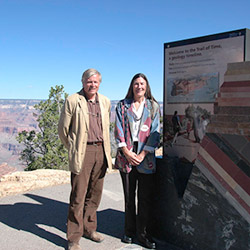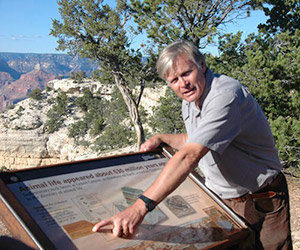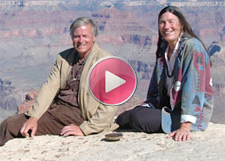This summer visitors to the site of the world’s grandest geologic landscape have been treated to the world’s largest geosciences exhibit, which opened recently after more than 15 years of planning and hard work. Under the leadership of UNM Professors Karl Karlstrom and Laura Crossey in the Department of Earth and Planetary Sciences, the nearly three-mile long interpretive Trail of Time utilizes the magnificent rocks and vistas within the Grand Canyon to tell an amazing geologic story.

Professors Karl Karlstrom and Laura Crossey
Karlstrom and Crossey conceived the project in 1995 and led the planning and installation of the exhibit along the South Rim of the Grand Canyon. They collaborated with the National Park Service and the National Science Foundation, which funded the project with a $2.1 million grant.
Other significant contributors to the project include Assistant Professor Steve Semken of the School of Earth and Space Exploration at Arizona State University, Professor Michael Williams of University of Massachusetts, and UNM graduate student Ryan Crow. Judy Bryan, chief of interpretation at Grand Canyon National Park, was the primary collaborator between the team and the National Park Service.
"The Trail of Time would have never happened without many people and many contributors," says Karlstrom. "We think it's important, as scientists, to partner with interpreters, evaluators, and exhibit and museum specialists who make their living talking to people. For us, the fact that this exhibit came from scientists, with a passion to bring new knowledge to the public is a special thing about the trail."
The idea for the Trail of Time came from Karlstrom's research group supported by the National Science Foundation. They had been working for about five years at the bottom of the canyon on river trips. One day they came up to the rim and wondered, 'what sorts of things do the public know about ongoing research, about the geology, and how well the Park is doing at interpreting geology?'
"We were really disappointed at the time," says Karlstrom. "The Yavapai Museum had been dismantled and there was very little geology interpretation at the park. So we said, 'guess it's our job as researchers to invigorate the park and improve geoscience education for the people from all over the world who visit the Grand Canyon.'"
Building the Trail

Creating the trail presented a number of challenges for the researchers, some nearly as enormous as the Grand Canyon's splendor. Originally, the vision involved bringing up, by helicopter, huge Volkswagen-sized rocks from each of the layers. These would be placed along the timeline at their proper time period, so visitors could get a sense of all the varieties of rock. However, the National Park Service saw things a little differently.
"That early picture showed children climbing on these big rocks and the National Park Service freaked out," says Karlstrom. "They said, 'this is a jungle gym—it's like Disneyland. That's not what the park does."
"The idea of taking big rocks out of the canyon also raised questions about environmental impact, so the approval to get rocks was ten years coming. I think we had to convince the park, and they had to convince themselves that seeing, touching, and appreciating rocks is part of the geologic understanding."
Karlstrom and the project team traveled along the Colorado River to collect most of the samples. Once the rocks were found and agreed upon, it took four strong individuals to carry the rocks out on a stretcher.
"We rafted along the Colorado River where you go through almost every rock layer," says Karlstrom. "We had these great searches for the best rocks. Some of them are so big or so remote that we had to get helicopter access. By this time the park had bought into the idea that the rocks were an essential part of the exhibit. They were very gracious in letting us use the park helicopter, and in one case, a heavy lift helicopter."
After the rocks were collected, they were shipped to Belen, New Mexico, and slabbed by New Mexico Travertine
“They did a beautiful job with these very special rocks," says Crossey. "Even though, in the early stages of the design, we were somewhat resigned that we would not be able to have the rock specimens. We were really pleased when that approval finally did come through. It's now clear that the rocks are the stars in this exhibit.The rocks are really the highlight for all ages."
The rocks were shipped back to the Grand Canyon and mounted along the trail on slabs of concrete with the age and type of rock emblazoned on the slab.
Students also took part in the project leaving their mark on the Trail of Time. "The Earth and Planetary Sciences Department has been dedicated to promoting undergraduate research in many forms," says Karlstrom. "We used classes to help formulate ideas. In Phase 1, students helped place 4,500 tick marks along the trail. The actual markers are bronze insets into the Trail—we were trying to create an unobtrusive exhibit that does not detract from the beauty of the Grand Canyon."
Along the Trail
The Trail of Time spans along the South Rim beginning at the Yavapai Observation Station. Walking west, each step takes visitors back in time one million years. The carving of the Grand Canyon is completed in the first six steps, the equivalent of six million years. The asphalt trail, with markers inset every ten meters, represents ten million years of Earth's history, and continues through the formation of Grand Canyon rock layers to the oldest rock in the canyon—recording a geologic history dating back more than 1.8 billion years.
"Geological time is the key to understanding evolution of the Earth and of life, and all three of these are core scientific ideas," says Semken of Arizona State. "Our hope is that Trail of Time visitors will walk away with a better understanding of how human time scales relate to geologic time scales.”
By walking the trail, visitors can get a sense of how long geologic time is. "Only" six million years ago, the carving of the canyon by the Colorado River began. The next major milestone is the Kaibab Formation, which is the top layer of the Grand Canyon. It was deposited 270 million years ago beneath a shallow sea. The lowest flat layer, Tapeats Sandstone, is 525 million years old. It's the oldest of the horizontal rock layers, but not the oldest rock in the canyon.
The Grand Canyon Supergroup, which includes a bright orange Hakatai Shale, is between 742 and 1,255 million years old. These layers were tilted and partly eroded before the flat layers were deposited on top. The Oldest Rocks are dark Basement Rocks that are between 1,660 and 1,840 million (1.66 to 1.84 billion) years old.
"It's like a trail of bread crumbs," Karlstrom says. "The vast majority of visitors can't go down into the canyon. The Trail of Time makes the Grand Canyon more accessible in a spectacular walk along the trail. The trail is also completely handicapped accessible."
"The Grand Canyon National Park has about five million visitors every year. Through the exhibit, we are making a major effort to catch people at a moment when they are inspired with the grandeur of the canyon, and want to understand more about how the landscape was shaped by geologic events," Karlstrom says.
"The high visitation and the spectacular geological landscape at Grand Canyon are two of the main reasons that we persevered so long to have this kind of a geoscience exhibit at this particular place," adds Crossey. "It's a place that's on everybody's must see lifetime list no matter where you are in the world."
Into the Future
As part of the grand opening, a symposium was held to come up with ideas to improve the Trail of Time.
"We think of the trail as a template for lots of other things, but don't know what all they'll be," says Karlstrom. "We hope these sorts of partnerships will continue and that the symposium we conducted will come up with some ideas with ways to expand the trail and continue on.
"It's a very important endeavor to increase science literacy in the U.S. and globally. The Grand Canyon has a tremendous international visitation. I want to look for other opportunities like the Trail of Time at other parks, and find ways to enhance its usefulness for visitors of the Grand Canyon."
A "Time Accelerator" portion of the trail will help visitors through a gradual transition in timescales from Yavapai Point to Grandeur Point. A Web-based Virtual Trail of Time is also planned to provide additional resources.
For more information about the Trail of Time visit: http://tot.unm.edu.
![Trail of Time Illustrates Geologic Splendor of Grand Canyon [article image]](trail-of-time/Trail-Header.jpg)

